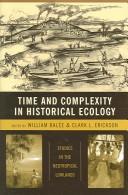| Listing 1 - 4 of 4 |
Sort by
|
Book
ISBN: 0817386556 9780817386559 9780817317867 0817317864 9780817358327 0817358323 Year: 2013 Publisher: Tuscaloosa : University of Alabama Press,
Abstract | Keywords | Export | Availability | Bookmark
 Loading...
Loading...Choose an application
- Reference Manager
- EndNote
- RefWorks (Direct export to RefWorks)
Cultural Forests of the Amazon is a comprehensive and diverse account of how indigenous people transformed landscapes and managed resources in the most extensive region of tropical forests in the world. Until recently, most scholars and scientists, as well as the general public, thought indigenous people had a minimal impact on Amazon forests, once considered to be total wildernesses. William Balée's research, conducted over a span of three decades, shows a more complicated truth. In Cultural Forests of the Amazon, he argues that indigenous people,
Rain forest ecology --- Cultural landscapes --- Traditional ecological knowledge --- Ethnoecology --- Urubu Kaapor Indians --- Indigenous peoples --- Human ecology --- Cultural geography --- Landscapes --- Landscape archaeology --- Indigenous ecological knowledge --- Indigenous environmental knowledge --- T.E.K. (Traditional ecological knowledge) --- TEK (Traditional ecological knowledge) --- Traditional environmental knowledge --- Ethnoscience --- Experiential learning --- Biopiracy --- Gaviao Indians --- Ka'apor Indians --- Kaapor Indians --- Urubu Indians --- Urubus Indians --- Indians of South America --- Tenetehara Indians --- Social conditions. --- Philosophy. --- Ethnobotany. --- Ecology --- Amazon River Region --- Amazonia --- Environmental conditions. --- Aboriginal peoples --- Aborigines --- Adivasis --- Indigenous populations --- Native peoples --- Native races --- Ethnology
Book
Year: 1984 Publisher: Ann Arbor, Mich. : UMI Dissertation Information Service,
Abstract | Keywords | Export | Availability | Bookmark
 Loading...
Loading...Choose an application
- Reference Manager
- EndNote
- RefWorks (Direct export to RefWorks)
Indians of South America --- Urubu Kaapor Indians --- Indiens d'Amérique --- Indiens Urubu --- Social life and customs --- Social life and customs. --- Moeurs et coutumes

ISBN: 0231509618 9780231509619 0231135629 9780231135627 Year: 2006 Publisher: New York Columbia University Press
Abstract | Keywords | Export | Availability | Bookmark
 Loading...
Loading...Choose an application
- Reference Manager
- EndNote
- RefWorks (Direct export to RefWorks)
This collection of studies by anthropologists, botanists, ecologists, and biologists is an important contribution to the emerging field of historical ecology. The book combines cutting-edge research with new perspectives to emphasize the close relationship between humans and their natural environment. Contributors examine how alterations in the natural world mirror human cultures, societies, and languages. Treating the landscape like a text, these researchers decipher patterns and meaning in the Ecuadorian Andes, Amazonia, the desert coast of Peru, and other regions in the neotropics. They show how local peoples have changed the landscape over time to fit their needs by managing and modifying species diversity, enhancing landscape heterogeneity, and controlling ecological disturbance. In turn, the environment itself becomes a form of architecture rich with historical and archaeological significance. Time and Complexity in Historical Ecology explores thousands of years of ecological history while also addressing important contemporary issues, such as biodiversity and genetic variation and change. Engagingly written and expertly researched, this book introduces and exemplifies a unique method for better understanding the link between humans and the biosphere.
Human ecology --- Rain forest ecology --- Ethnobiology --- Agriculture --- Land use --- Landscape changes --- Land --- Land utilization --- Use of land --- Utilization of land --- Economics --- Land cover --- Landscape assessment --- NIMBY syndrome --- Change, Landscape --- Geomorphology --- Folk biology --- Folkbiology --- Indigenous peoples --- Traditional biology --- Biology, Economic --- Ethnoscience --- Equatorial forest ecology --- Rain forests --- Tropical rain forest ecology --- Forest ecology --- Ecology --- Environment, Human --- Human beings --- Human environment --- Ecological engineering --- Human geography --- Nature --- Social aspects --- Effect of environment on --- Effect of human beings on

ISBN: 9780231509619 9780231135627 0231509618 Year: 2006 Publisher: New York : Columbia University Press,
Abstract | Keywords | Export | Availability | Bookmark
 Loading...
Loading...Choose an application
- Reference Manager
- EndNote
- RefWorks (Direct export to RefWorks)
This collection of studies by anthropologists, botanists, ecologists, and biologists is an important contribution to the emerging field of historical ecology. The book combines cutting-edge research with new perspectives to emphasize the close relationship between humans and their natural environment. Contributors examine how alterations in the natural world mirror human cultures, societies, and languages. Treating the landscape like a text, these researchers decipher patterns and meaning in the Ecuadorian Andes, Amazonia, the desert coast of Peru, and other regions in the neotropics. They show how local peoples have changed the landscape over time to fit their needs by managing and modifying species diversity, enhancing landscape heterogeneity, and controlling ecological disturbance. In turn, the environment itself becomes a form of architecture rich with historical and archaeological significance. Time and Complexity in Historical Ecology explores thousands of years of ecological history while also addressing important contemporary issues, such as biodiversity and genetic variation and change. Engagingly written and expertly researched, this book introduces and exemplifies a unique method for better understanding the link between humans and the biosphere.
Pure sciences. Natural sciences (general) --- Human ecology --- Rain forest ecology --- Ethnobiology --- Agriculture --- Land use --- Landscape changes
| Listing 1 - 4 of 4 |
Sort by
|

 Search
Search Feedback
Feedback About UniCat
About UniCat  Help
Help News
News